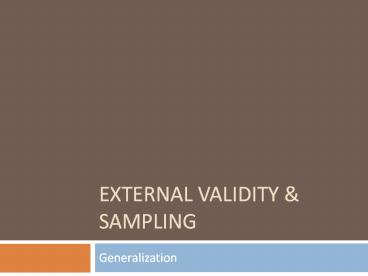External validity PowerPoint PPT Presentation
1 / 12
Title: External validity
1
External validity Sampling
- Generalization
2
External Validity
- the approximate truth of conclusions that involve
generalizations - the degree to which the conclusions in a study
would hold for other persons in other places and
at other times
Key Question How reasonable is it to believe that
the result found in this study would be the same
with other people, in other places, at other
times?
3
External Validity and Sampling
- Sampling
- process of selecting units (e.g., people,
organizations, occasions) from a population of
interest so that by studying the sample you can
fairly or reasonably generalize your results to
the population from which the units were chosen - primary approach is referred to as the sampling
model
4
Sampling Model
Generalize back
Population
Draw sample
Sample
5
Sampling Model
- The goal is to claim representative sampling
- potential problems
- knowing the population you want to generalize to
in the first place - ability to draw a representative sample
- ability to sample across all times
- We can never generalize with absolute certainty,
rather we have to decide how reasonable is it to
assume similar results give different
circumstances
6
Threats to External Validity
Interaction of selection and treatment
Maybe it is just these people.
Interaction of setting and treatment
Maybe it is just these places.
Interaction of history and treatment
Maybe it is just these times.
7
Improving External Validity
Replicate, Replicate, Replicate
8
Types of Sampling
Probability sampling
Uses some form of random selection, and requires
that each unit have a known (often equal)
probability of being selected
Non-probability sampling
selection is systematic or haphazard, but not
random
9
Practice Question
- To study exercisers in Bloomington/Normal, a
researcher drew 2 health clubs at random (both of
which happened to be large clubs open to the
general public with hundreds of members) to
recruit participants from. Do you think this will
be a representative sample? Why or why not?
10
Practice Question
- A poll was conducted by a magazine editor by
printing a questionnaire in an issue of the
magazine for readers to mail back. Thousands of
readers returned completed questionnaires.
Suppose a friend reads the results and is
convinced that it reflects the view of all
adults. What would you say to convince your
friend that he/she might be wrong?
11
Guiding Questions for Critiquing the External
Validity of Research
- What are the main results of the study (e.g.,
positive or negative relationship, group
differences, effectiveness of the intervention or
treatment)? - Do the researchers explicitly state or imply that
similar results would hold for other (a) people,
(b) places or situations, and/or (c) times? If
so, what is the population/place/time they are
attempting to generalize to? - If the researchers are generalizing their
results, how reasonable are these conclusions
given the sample, sampling procedures, and
settings used? This is the key External Validity
question - What specifically might lead you to question
these conclusions? In other words, if they did
suggest the results were generalizable, why might
you think otherwise? The more convincing of a
rationale you can generate, the more you should
question the external validity
12
Use the guiding questions to evaluate the
external validity of the following study
- Prior research has found that (a) intercollegiate
athletes are especially at-risk for excessive
alcohol consumption (e.g., Nelson Wechsler,
2001), and (b) sport-type differences exist among
college athletes in terms of yearly drinking
prevalence rates (National Collegiate Athletic
Association, 2001). No studies, however, have
examined sport-type differences on more specific
measures of alcohol consumption (i.e., drinks per
week). In the present study, data were analyzed
on 298 intercollegiate athletes from two
different NCAA Division III universities. Results
indicated significant sport type differences on
alcohol consumption variables, with athletes from
the sports of swimming and diving and wrestling
reporting the highest levels of alcohol
consumption (M 5.20, SD 4.00) and soccer and
football reporting the lowest (M 4.02, SD
3.25). Results suggest college athletes
participating in individual sports are at-risk
for future alcohol abuse.

